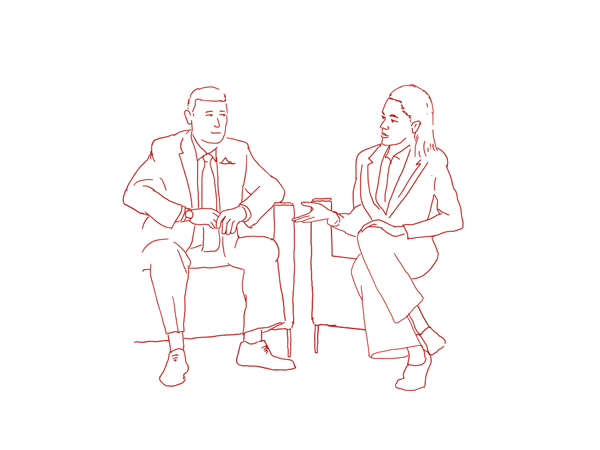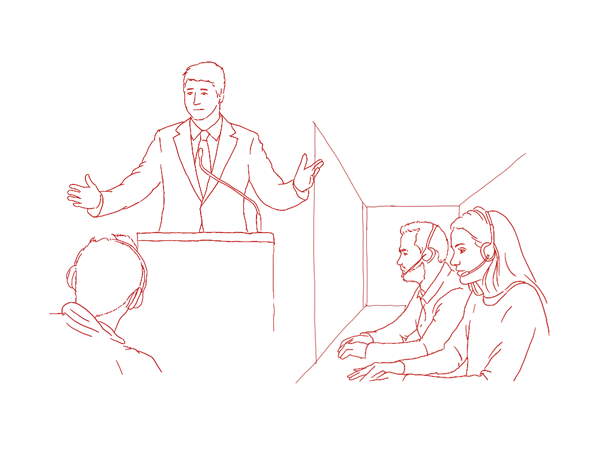
Interpreting at meetings (consecutive)
Interpreting at meetings (consecutive)
The speaker and interpreter take turns talking. You have probably encountered this type of interpreting at lectures and similar events. Consecutive interpreting is often used during business meetings and training sessions.
We can also take notes while the speaker is talking and reproduce their message once they are finished speaking, so that they can complete a full thought without having to pause for interpreting after each sentence.
Rečník delí svoj prejav na krátke úseky, ktoré tlmočník postupne tlmočí (tlmočník s rečníkom sa v hovorení striedajú). S takýmto tlmočením ste sa už určite stretli na rôznych prednáškach. Konzekutívne tlmočenie sa často používa na obchodných rokovaniach alebo školeniach.
Ovládame aj techniku tlmočníckeho zápisu – nebudeme vám teda skákať do reči po každej vete, preto môžete bez obáv vyjadriť aj dlhšie súvislé myšlienky, ktoré verne zreprodukujeme.
Rečník delí svoj prejav na krátke úseky, ktoré tlmočník postupne tlmočí (tlmočník s rečníkom sa v hovorení striedajú). S takýmto tlmočením ste sa už určite stretli na rôznych prednáškach. Konzekutívne tlmočenie sa často používa na obchodných rokovaniach alebo školeniach.
Ovládame aj techniku tlmočníckeho zápisu – nebudeme vám teda skákať do reči po každej vete, preto môžete bez obáv vyjadriť aj dlhšie súvislé myšlienky, ktoré verne zreprodukujeme.
The speaker and interpreter take turns talking. You have probably encountered this type of interpreting at lectures and similar events. Consecutive interpreting is often used during business meetings and training sessions.
We can also take notes while the speaker is talking and reproduce their message once they are finished speaking, so that they can complete a full thought without having to pause for interpreting after each sentence.

Conference interpreting (simultaneous)
Conference interpreting (simultaneous)
The interpreter speaks directly into the audience’s ears, and the speaker does not have to pause for interpreting. You most often see simultaneous interpreting on television, where people speaking other languages are dubbed over as they speak, or at conferences with attendees from other countries. This type of interpreting requires special equipment (interpreting headsets and microphone) and typically involves two interpreters who take turns in order to maintain consistently high quality.
Tlmočenie prebiehajúce súbežne s prejavom rečníka. Tlmočník tlmočí prejav priamo do uší poslucháčov bez toho, aby musel rečník zohľadňovať, že jeho slová sa tlmočia. V bežnom živote sa so simultánnym tlmočením najčastejšie stretnete v televízii, kde sa týmto spôsobom tlmočia prejavy zahraničných hostí, alebo na konferenciách so zahraničnými účastníkmi. Pri tomto druhu tlmočenia je nevyhnutná tlmočnícka technika (technické zariadenie na tlmočenie) a obvykle dvojica tlmočníkov, ktorí sa v tlmočení striedajú, aby sa zachovala kvalita tlmočenia.
Simultánne tlmočenie je vhodné na konferencie, rokovania s viacerými zahraničnými účastníkmi, vzdelávacie semináre, prednášky, tlačové konferencie, čiže všade tam, kde by konzekutívne tlmočenie bolo príliš zdĺhavé, a tam, kde je možné nainštalovať tlmočnícku kabínu.
Tlmočenie prebiehajúce súbežne s prejavom rečníka. Tlmočník tlmočí prejav priamo do uší poslucháčov bez toho, aby musel rečník zohľadňovať, že jeho slová sa tlmočia. V bežnom živote sa so simultánnym tlmočením najčastejšie stretnete v televízii, kde sa týmto spôsobom tlmočia prejavy zahraničných hostí, alebo na konferenciách so zahraničnými účastníkmi. Pri tomto druhu tlmočenia je nevyhnutná tlmočnícka technika (technické zariadenie na tlmočenie) a obvykle dvojica tlmočníkov, ktorí sa v tlmočení striedajú, aby sa zachovala kvalita tlmočenia.
Simultánne tlmočenie je vhodné na konferencie, rokovania s viacerými zahraničnými účastníkmi, vzdelávacie semináre, prednášky, tlačové konferencie, čiže všade tam, kde by konzekutívne tlmočenie bolo príliš zdĺhavé, a tam, kde je možné nainštalovať tlmočnícku kabínu.
The interpreter speaks directly into the audience’s ears, and the speaker does not have to pause for interpreting. You most often see simultaneous interpreting on television, where people speaking other languages are dubbed over as they speak, or at conferences with attendees from other countries. This type of interpreting requires special equipment (interpreting headsets and microphone) and typically involves two interpreters who take turns in order to maintain consistently high quality.

Consulting
Consulting
We will be happy to advise you on which type of interpreting is most appropriate for you, including all the advantages and disadvantages involved, using normal language – not professional jargon. Are you looking for languages other than English, Slovak and German? We have a large network of excellent colleagues in other language combinations, and we are happy to refer you to them as needed, as we have worked with them many times in the past. We provide referrals free of charge.
Rečník delí svoj prejav na krátke úseky, ktoré tlmočník postupne tlmočí (tlmočník s rečníkom sa v hovorení striedajú). S takýmto tlmočením ste sa už určite stretli na rôznych prednáškach. Konzekutívne tlmočenie sa často používa na obchodných rokovaniach alebo školeniach.
Ovládame aj techniku tlmočníckeho zápisu – nebudeme vám teda skákať do reči po každej vete, preto môžete bez obáv vyjadriť aj dlhšie súvislé myšlienky, ktoré verne zreprodukujeme.
Rečník delí svoj prejav na krátke úseky, ktoré tlmočník postupne tlmočí (tlmočník s rečníkom sa v hovorení striedajú). S takýmto tlmočením ste sa už určite stretli na rôznych prednáškach. Konzekutívne tlmočenie sa často používa na obchodných rokovaniach alebo školeniach.
Ovládame aj techniku tlmočníckeho zápisu – nebudeme vám teda skákať do reči po každej vete, preto môžete bez obáv vyjadriť aj dlhšie súvislé myšlienky, ktoré verne zreprodukujeme.
We will be happy to advise you on which type of interpreting is most appropriate for you, including all the advantages and disadvantages involved, using normal language – not professional jargon. Are you looking for languages other than English, Slovak and German? We have a large network of excellent colleagues in other language combinations, and we are happy to refer you to them as needed, as we have worked with them many times in the past. We provide referrals free of charge.

Conference interpreting (full service)
Conference interpreting
(full service)
Will you be needing more than two languages at your event? We’ll put together a team of interpreters for you who are accustomed to working at multilingual events. Unlike a language agency, we provide this service free of charge. We are also happy to recommend a reliable sound company we have worked with for years. Alternatively, if you are planning a small event with a limited number of attendees, we can provide the equipment ourselves, so you won’t have to pay extra.
Tlmočenie prebiehajúce súbežne s prejavom rečníka. Tlmočník tlmočí prejav priamo do uší poslucháčov bez toho, aby musel rečník zohľadňovať, že jeho slová sa tlmočia. V bežnom živote sa so simultánnym tlmočením najčastejšie stretnete v televízii, kde sa týmto spôsobom tlmočia prejavy zahraničných hostí, alebo na konferenciách so zahraničnými účastníkmi. Pri tomto druhu tlmočenia je nevyhnutná tlmočnícka technika (technické zariadenie na tlmočenie) a obvykle dvojica tlmočníkov, ktorí sa v tlmočení striedajú, aby sa zachovala kvalita tlmočenia.
Simultánne tlmočenie je vhodné na konferencie, rokovania s viacerými zahraničnými účastníkmi, vzdelávacie semináre, prednášky, tlačové konferencie, čiže všade tam, kde by konzekutívne tlmočenie bolo príliš zdĺhavé, a tam, kde je možné nainštalovať tlmočnícku kabínu.
Tlmočenie prebiehajúce súbežne s prejavom rečníka. Tlmočník tlmočí prejav priamo do uší poslucháčov bez toho, aby musel rečník zohľadňovať, že jeho slová sa tlmočia. V bežnom živote sa so simultánnym tlmočením najčastejšie stretnete v televízii, kde sa týmto spôsobom tlmočia prejavy zahraničných hostí, alebo na konferenciách so zahraničnými účastníkmi. Pri tomto druhu tlmočenia je nevyhnutná tlmočnícka technika (technické zariadenie na tlmočenie) a obvykle dvojica tlmočníkov, ktorí sa v tlmočení striedajú, aby sa zachovala kvalita tlmočenia.
Simultánne tlmočenie je vhodné na konferencie, rokovania s viacerými zahraničnými účastníkmi, vzdelávacie semináre, prednášky, tlačové konferencie, čiže všade tam, kde by konzekutívne tlmočenie bolo príliš zdĺhavé, a tam, kde je možné nainštalovať tlmočnícku kabínu.
Will you be needing more than two languages at your event? We’ll put together a team of interpreters for you who are accustomed to working at multilingual events. Unlike a language agency, we provide this service free of charge. We are also happy to recommend a reliable sound company we have worked with for years. Alternatively, if you are planning a small event with a limited number of attendees, we can provide the equipment ourselves, so you won’t have to pay extra.
How does interpreting work?
How do I figure out if I need simultaneous or consecutive interpreting?
How do I figure out if I need simultaneous or consecutive interpreting?
Just ask! We have plenty of experience interpreting all kinds of events, so we will be happy to advise you on the advantages and disadvantages of the various types of interpreting.
With simultaneous interpreting everything goes on at once: the speaker speaks and the audiences hears the interpreted speech in real time, so there is no time delay and listeners may not even notice that the lecture (for instance) is being given in another language. The speaker can also gauge audience reactions in real time, instead of having to wait for the interpreter to finish speaking, as is the case with consecutive interpreting. That is more appropriate at press conferences, for instance, where headsets would only get in the way.
With simultaneous interpreting, people who understand the original language can listen to the speaker directly without being distracted by the interpreter. Consecutive interpreting is tiring for the audience, especially if it lasts more than a few minutes (like a whole presentation), and it makes everything take twice as long. It is often the most appropriate choice for business meetings, however.
On the other hand, consecutive interpreting is significantly cheaper, since it does not require any special equipment. Consecutive interpreting is ideal for smaller venues and shorter periods, such as bilateral talks, press conferences, business meetings, or anywhere where we can’t set up equipment for simultaneous interpreting.
Just ask! We have plenty of experience interpreting all kinds of events, so we will be happy to advise you on the advantages and disadvantages of the various types of interpreting.
With simultaneous interpreting everything goes on at once: the speaker speaks and the audiences hears the interpreted speech in real time, so there is no time delay and listeners may not even notice that the lecture (for instance) is being given in another language. The speaker can also gauge audience reactions in real time, instead of having to wait for the interpreter to finish speaking, as is the case with consecutive interpreting. That is more appropriate at press conferences, for instance, where headsets would only get in the way.
With simultaneous interpreting, people who understand the original language can listen to the speaker directly without being distracted by the interpreter. Consecutive interpreting is tiring for the audience, especially if it lasts more than a few minutes (like a whole presentation), and it makes everything take twice as long. It is often the most appropriate choice for business meetings, however.
On the other hand, consecutive interpreting is significantly cheaper, since it does not require any special equipment. Consecutive interpreting is ideal for smaller venues and shorter periods, such as bilateral talks, press conferences, business meetings, or anywhere where we can’t set up equipment for simultaneous interpreting.
What is interpreting equipment?
What is interpreting equipment?
The equipment needed for interpreting depends on the type of interpreting.
With consecutive interpreting the audience just needs to be able to hear us, so we only need a microphone (if that).
Simultaneous interpreting is a bit more involved. We need an interpreter’s booth (a sound-proof booth or room), audio from the speaker with volume control, and a microphone. Listeners usually hear the interpreter’s voice through earphones.
The equipment needed for interpreting depends on the type of interpreting.
With consecutive interpreting the audience just needs to be able to hear us, so we only need a microphone (if that).
Simultaneous interpreting is a bit more involved. We need an interpreter’s booth (a sound-proof booth or room), audio from the speaker with volume control, and a microphone. Listeners usually hear the interpreter’s voice through earphones.
What does the interpreter need?
What does the interpreter need?
Good sound equipment. It might seem like a minor detail, but being able to hear everything the speaker says is half the battle.
Another important detail is a lunch break. On an all-day interpreting assignment, interpreters also need the opportunity to rest and recharge. Please also keep in mind that interpreting requires a great deal of concentration and no one can do it all day with no breaks without impacting quality.
And water. Talking non-stop dries out the throat quite quickly.
Good sound equipment. It might seem like a minor detail, but being able to hear everything the speaker says is half the battle.
Another important detail is a lunch break. On an all-day interpreting assignment, interpreters also need the opportunity to rest and recharge. Please also keep in mind that interpreting requires a great deal of concentration and no one can do it all day with no breaks without impacting quality.
And water. Talking non-stop dries out the throat quite quickly.
What will the interpreter need from me before the interpreting assignment starts?
What will the interpreter need from me before the interpreting assignment starts?
Most importantly, we need to know the topic, so we can decide whether to take the job ourselves or refer you to a colleague with more experience in that area. We also need as much background material as you can give us. Any information about the company or speaker (website, brochures, etc.), materials on the topic of the presentation or meeting, and the names (and profiles, if possible) of the people present will help us prepare for the assignment. On the day of the event, we need to know as much as possible about the topic. We will have already studied it in detail before coming. Thorough preparation and study helps us avoid any unintentional blunders or miscommunications.
Most importantly, we need to know the topic, so we can decide whether to take the job ourselves or refer you to a colleague with more experience in that area. We also need as much background material as you can give us. Any information about the company or speaker (website, brochures, etc.), materials on the topic of the presentation or meeting, and the names (and profiles, if possible) of the people present will help us prepare for the assignment. On the day of the event, we need to know as much as possible about the topic. We will have already studied it in detail before coming. Thorough preparation and study helps us avoid any unintentional blunders or miscommunications.
Do we really need two interpreters for simultaneous interpreting?
Do we really need two interpreters for simultaneous interpreting?
You certainly do, if you want the interpreting to be done to a professional standard.
Simultaneous interpreting is extremely demanding and mentally draining. Not even the best interpreters in the world can interpret for more than half an hour at a time without having a negative impact on quality. That’s why the interpreter’s booth should always have two interpreters taking turns. After all, no one wants to stop the conference just so the interpreter can take a break.
You certainly do, if you want the interpreting to be done to a professional standard.
Simultaneous interpreting is extremely demanding and mentally draining. Not even the best interpreters in the world can interpret for more than half an hour at a time without having a negative impact on quality. That’s why the interpreter’s booth should always have two interpreters taking turns. After all, no one wants to stop the conference just so the interpreter can take a break.
I want someone to interpret me. What does this involve and what do you need from me?
I want someone to interpret me. What does this involve and what do you need from me?
- As much information as possible about the event program, attendees, speakers, and if possible the actual materials or presentations the speakers will be using
- For simultaneous interpreting you will need to secure the equipment (we can recommend reliable suppliers)
- For non-traditional events, we will need a clear brief on what, when and for whom we will be interpreting
- For events with interpreting into multiple languages, we will need contact information for the other interpreters
- For events outside our home territory (Bratislava and the surrounding area), we will need to agree on accommodations and travel.
Most importantly, we need to know the topic, so we can decide whether to take the job ourselves or refer you to a colleague with more experience in that area. We also need as much background material as you can give us. Any information about the company or speaker (website, brochures, etc.), materials on the topic of the presentation or meeting, and the names (and profiles, if possible) of the people present will help us prepare for the assignment. On the day of the event, we need to know as much as possible about the topic. We will have already studied it in detail before coming. Thorough preparation and study helps us avoid any unintentional blunders or miscommunications.
Contact:
Pavol Šveda — sveda@interpreters.sk
Henriette Geierová — geierova@interpreters.sk
Ivo Poláček — polacek@interpreters.sk
Mária Mlynarčíková — mlynarcikova@interpreters.sk
© interpreters.sk 2018



